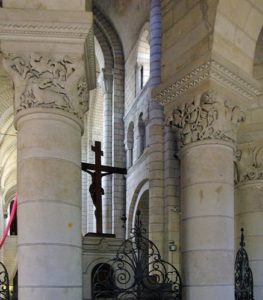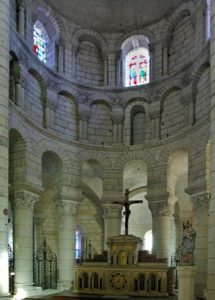Seen from the river, St-Aignan is dominate by the château (private) and Romanesque church which are at the heart of the old medieval town.
Collegiale de St-Aignan was built in the 11thC over the remains of an earlier church which now forms the crypt. It has twin square towers at either end of the nave. topped by pyramid domes. Inside are some remarkably well preserved frescoes dating from the 12thC. The Chapelle de Miracles is a joy and delight with the wow factor.
It was late afternoon when we visited and all the visitors had left. We had the church to ourselves.
We went in through the south door which is very decorative. Twisted pillars with carved capitals support elaborately carved round arches. There is a narrow carved frieze along the walls and up over the windows as well as carved supports under the eaves of the roof. There is a massive west porch beneath the tower which has round arches and unfortunately lots of graffiti (one of the few places we saw this). There are huge buttresses on the tower and also along the sides of the nave. The top of the tower has open round topped bell windows with more carved supports beneath the roof and a cornice with carved supports beneath the windows.
Music was playing in the church, adding to the atmosphere. There is a very long and tall nave. Round pillars support round arches between the nave and side aisles. Above are round topped windows. Longer wall pillars support the ribs of the vaulted ceiling. All have beautifully carved capitals with Biblical scenes, mythical animals or abstract designs. There are additional slightly pointed arches providing support in the the side aisles. The walls are bare apart from small carved stations of the cross and a memorial to the dead of World War One with nearly 100 names. Long white and red drapes hang down from the transept tower.
Next to south door is Chapelle de Miracles with 12thC frescoes, now much blackened with time. This is completely unexpected and so beautiful. The vaulted roof is covered with frescoes. There are the four evangelists. St Michael is slaying the dragon, the Angel of Justice weighing souls and there is the Annunciation with Gabriel. The white altar is decorated with a gold sun burst below. The reredos has gold fluted pillars and two lines of sheaves of wheat on the shelves. The host box is white with a gold ostensoire on the door. Above is a marble statue of the Virgin Mary with a gold shawl. On either side are two old and dark brown wooden statues. The wall behind the altar is painted with angels on either side of a round window with blue and red glass and stained glass windows on either side. There is an icon of Marie les Enfants on the wall as well as ‘Merci’ plates and lighted candles.
The north wall opposite the Chapelle de Miracles has a statue of Joseph with the boy Jesus and candles.
At the east end of the church is a rounded apse which forms the chancel which has an ambulatory round it. There is a free standing mass altar in the transept. The high altar is very ornate and inlaid with gilt and black mosaics. The marble pillars and arches on the base contain the names of the four evangelists. The middle panel has the Chi-Rho symbol with alpha and omega on either side. Above is a beautiful host box with pillars, round arches and decorative gilt mosaic work. The shelves on either side have gilt scrolls on a black background. Above is a crucifix. In front to the side is a painted statue of the crowned Virgin holding the Christ Child. The chancel is lined with old wooden choir stalls.
The round pillars of the ambulatory have glorious carved capitals with Biblical scenes. There is the slaughter of the innocents and the flight into Egypt with Joseph leading a donkey carrying Mary and Jesus. At the base are decorative wrought iron screens separating the chancel from the ambulatory. There are more pillars with carved capitals and blank round arches on the wall above. The top level has round arches and stained glass windows. The three apses off the ambulatory are separated by round pillars and more carved capitals. There are altars with statues in each. There is a bishop on the south altar, the Virgin and child with ‘merci’ plates in centre and Joan of Arc on the north altar.
Steps by north wall lead down into the crypt. This is huge and stretches from the transept to the end of the chancel. It is made up of an antechamber, main chamber and ambulatory. The pillars supporting the round arches have carved capitals but are less elaborate than in the church. The walls are covered in frescoes of varying degrees of preservation. Colours are mainly oranges, reds and yellows with traces of blue in places. On the west wall is the crucifixion. On the east wall is Christ in Majesty. On the north wall are the Annunciation and birth of Christ and on the south wall is Mary collecting the body for burial. Next to this are two praying figures on either side of an angel holding a cross. (These aren’t very clear and only the outline survives.) There are three apses off the ambulatory. The south apse has a fresco of the Lamb of God on the roof with a border of saints underneath. The central apse fresco is in poor condition and there are the vague outlines of figures. The north apse has frescoes and a few bits of masonry on the floor. Neglected in a corner at the back is the remains of an old altar with a host box. A few long thin windows let in light although it is now lit with electric light.
The church was one of the highlights of our week in the Lore Valley. The frescoes and particularly the Chapelle de Miracles are superb.










